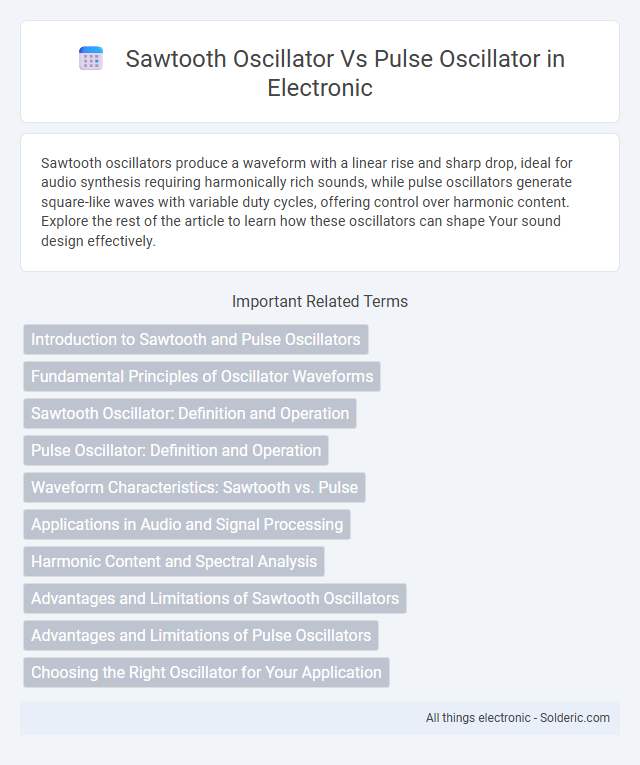Sawtooth oscillators produce a waveform with a linear rise and sharp drop, ideal for audio synthesis requiring harmonically rich sounds, while pulse oscillators generate square-like waves with variable duty cycles, offering control over harmonic content. Explore the rest of the article to learn how these oscillators can shape Your sound design effectively.
Comparison Table
| Feature | Sawtooth Oscillator | Pulse Oscillator |
|---|---|---|
| Waveform Shape | Linear rising/falling ramp | Square-like pulse with adjustable duty cycle |
| Frequency Range | Wide, depends on design and components | Wide, highly flexible with duty cycle control |
| Harmonic Content | Rich in odd and even harmonics | Rich in odd harmonics, duty cycle affects spectrum |
| Common Uses | Audio synthesis, modulation, sweep generation | PWM, timing circuits, digital clocks |
| Duty Cycle Control | No, fixed linear ramp | Yes, adjustable pulse width |
| Complexity | Simple to moderate | Simple, often uses comparators or timers |
| Output Symmetry | Asymmetric waveform | Symmetric or asymmetric depending on duty cycle |
Introduction to Sawtooth and Pulse Oscillators
Sawtooth oscillators generate a waveform that linearly ramps up or down before sharply dropping, ideal for synthesizing rich harmonic content in audio and signal processing applications. Pulse oscillators produce square-like waveforms with adjustable duty cycles, allowing precise control over the waveform's tonal character and timing in digital circuits. Understanding the distinct waveform shapes of sawtooth and pulse oscillators helps optimize Your sound design or electronic circuit performance.
Fundamental Principles of Oscillator Waveforms
Sawtooth oscillators generate waveforms that linearly rise or fall over time, creating rich harmonic content with both even and odd harmonics, ideal for synthesizing bright, buzzy sounds. Pulse oscillators produce rectangular waveforms characterized by rapid transitions between high and low states, with adjustable duty cycles that influence harmonic emphasis and timbre variation. Understanding these fundamental waveform differences helps you choose the right oscillator for desired tonal characteristics in audio synthesis or signal processing applications.
Sawtooth Oscillator: Definition and Operation
A sawtooth oscillator generates a waveform characterized by a linear rise in voltage followed by a sharp drop, producing a distinctive "sawtooth" shape ideal for audio synthesis and modulation applications. It operates by charging a capacitor steadily and then quickly discharging it, creating a repetitive ramp-up and sudden reset pattern. Your sound design benefits from the rich harmonic content of the sawtooth waveform, offering brighter and more complex tones compared to pulse oscillators.
Pulse Oscillator: Definition and Operation
A pulse oscillator generates a waveform characterized by rapid transitions between high and low voltage levels, creating a square or rectangular pulse shape with adjustable duty cycles. This type of oscillator operates by charging and discharging a timing capacitor through a controlled switching device, ensuring precise control over pulse width and frequency. Your electronic circuits benefit from pulse oscillators in applications requiring stable and repeatable digital signal generation, such as clock pulses and timing references.
Waveform Characteristics: Sawtooth vs. Pulse
Sawtooth oscillators generate a waveform with a linear rise followed by an abrupt drop, producing rich harmonic content ideal for synthesizing brass and string sounds. Pulse oscillators create rectangular waveforms with adjustable duty cycles, offering versatile tonal variations from hollow to nasal timbres by altering the pulse width. The distinct harmonic spectra of sawtooth and pulse waves make them fundamental tools in sound design and synthesis.
Applications in Audio and Signal Processing
Sawtooth oscillators generate rich harmonic content ideal for synthesizers and audio signal processing requiring complex waveforms, while pulse oscillators offer adjustable duty cycles suited for pulse-width modulation in communication systems and digital sound synthesis. Your choice depends on whether you need a harmonically dense signal or precise control over pulse characteristics for audio effects and signal modulation tasks. Both oscillators are fundamental in creating distinct timbres and modulation patterns in electronic music production and signal processing applications.
Harmonic Content and Spectral Analysis
Sawtooth oscillators produce a rich harmonic spectrum containing both even and odd harmonics, resulting in a bright and buzzy timbre ideal for complex sound synthesis. Pulse oscillators generate waveforms with adjustable duty cycles, predominantly featuring odd harmonics, which allows for variable tonal character by altering pulse width. Spectral analysis reveals sawtooth waves with a linear harmonic decay, while pulse waves exhibit harmonics that diminish according to the pulse width, affecting the harmonic density and perceived brightness.
Advantages and Limitations of Sawtooth Oscillators
Sawtooth oscillators generate waveforms with a linear rise and a sharp drop, making them ideal for applications requiring harmonically rich signals like synthesizers and waveform modulation. Their primary advantages include simple circuit design and compatibility with phase-locked loops, but limitations involve significant harmonic distortion and higher power consumption compared to pulse oscillators. Sawtooth oscillators may also introduce noise and are less efficient in digital switching environments where pulse oscillators excel.
Advantages and Limitations of Pulse Oscillators
Pulse oscillators deliver sharp, well-defined waveforms ideal for digital timing and clock generation, offering high frequency stability and fast switching speeds. Their limitations include higher harmonic distortion compared to sawtooth oscillators, which can introduce noise in analog signal processing applications. Unlike sawtooth oscillators that produce linear ramps beneficial for audio synthesis, pulse oscillators are less suited for smooth waveform generation but excel in precise pulse-width modulation tasks.
Choosing the Right Oscillator for Your Application
Selecting the right oscillator depends on your application's requirements for waveform shape and harmonic content; sawtooth oscillators generate a linear ramp waveform rich in harmonics ideal for complex synth sounds, while pulse oscillators provide adjustable duty cycles with sharper transitions suited for rhythm and modulation effects. Your choice should consider factors like tonal complexity, signal sharpness, and control flexibility, as sawtooth waveforms deliver fuller, brighter timbres whereas pulse waves offer dynamic pulse-width modulation opportunities. Evaluating these distinctions ensures optimal sound design tailored to your specific audio synthesis needs.
sawtooth oscillator vs pulse oscillator Infographic

 solderic.com
solderic.com